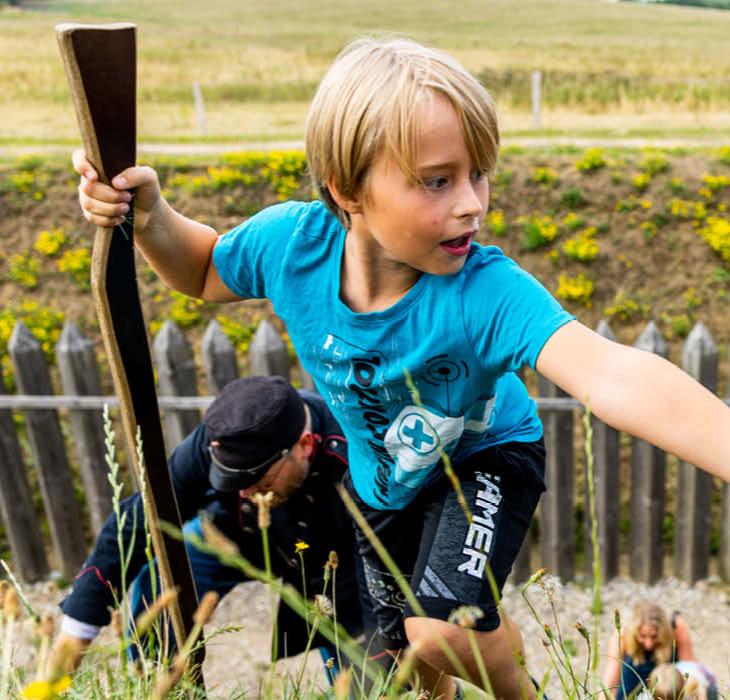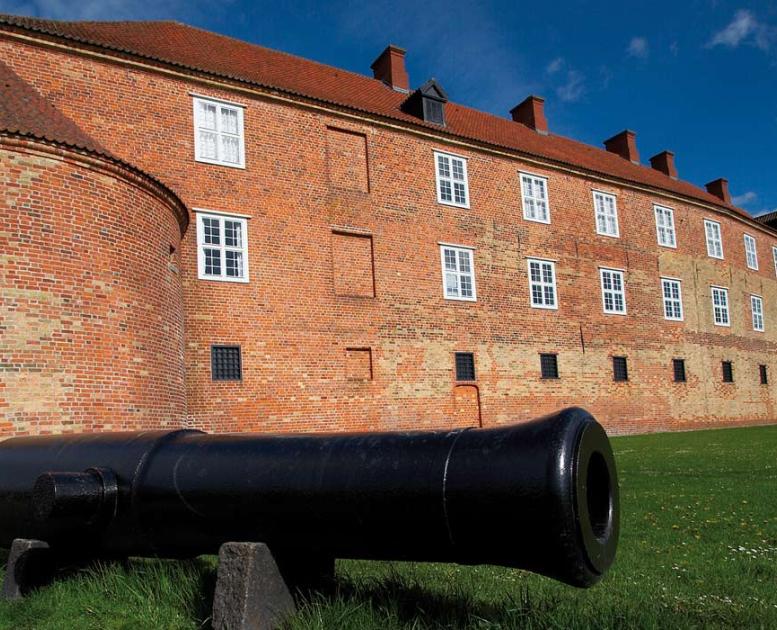The Museum at Sønderborg Castle
Learn more about the history and cultural heritage of South Jutland with a visit to the Museum Sønderjylland in the historic setting of Sønderborg Castle


The largest collection of burial mounds in Sønderjylland is found on the island of Als. Unique boat finds from both the older and younger Iron Age. The national symbol Dybbøl Mølle and the scenic area Dybbøl Banke, where blood was shed in 1864.
The Museum Sønderjylland at Sønderborg Castle not only showcases exhibitions on the castle's history but also covers a broad spectrum of Sønderjylland's history under one roof. Many other museums and collections also have exciting stories and discoveries.
Since the commemoration of the 100th anniversary of the Reunification in 1920, we have enjoyed a newly created museum in Sønderborg, where you can visit the Deutsches Museum Nordschleswig. It is a modern and interactive museum that provides insights into the history of the German minority.
Sønderjylland's tradition of tilting-at-the-ring originally hails from Augustenborg, and you can find Denmark's only tilting-at-the-ring museum in one of the oldest houses in Sønderborg.
In the summer time, our splendid guides take you on a tour through exciting history and myths of the Sønderborg area.
We have the largest of them all! Like the rest of Denmark, the Sønderborg-area is swarming with relics of antiquities – we just have some that stands out.
At the east coast of island Als lies the small forest Blomeskobbel and here you´ll find Sønderjylland´s largest collection of burial mounds and barrows. How did they do it? The large cover stone on one of the long barrows weighs approx. 20 ton and there were no machines in the Stone Age!
The burial mound, Skelde Gravhøj, is amongst the unique in Denmark! Danish Agency for Culture and Palaces has selected 83 locations within history of civilization in Denmark for a project named “Denmark´s relics in the landscape” amongst them is Skelde Burial Mound, found on Broagerland.
Where you aware of the fact, that one of the known archaeologists in Denmark, Jens Raben grounded the collection which was the beginning of the museum at Sønderborg Castle?
Then there is Jørgen Rieck, who is reckoned to have the largest private collection of relics in Denmark, visit the old school in Svenstrup on island Als and see Jørgen Riecks Archeological Collection.
An 8-year-old boy's discovery of a flint tool led to a collection that is now widely known in archaeological circles.
We know that there have been disagreements and conflicts in our area for a long time. This is evidenced by the sensational maritime sacrificial finds in Hjortspring Mose and Nydam Mose.
The war of 1864 is literally the most defining in Sønderjylland's history, where the loss to the Prussians leads to a new border along the watercourse,Kongeå. The occupation lasts for 57 years and has fateful consequences in 1914-18, as men in World War I are conscripted into the German army and, for some, goes to war for a country they do not love.
Today, there is hardly a cemetery in Sønderjylland without memorial stones for fallen soldiers. Around Sønderborg, you can also find crosses and gravestones for those who fell in 1864, and there is even a memorial stone in Norway.
The loss of World War I turns into a victory for most Danish-minded individuals who, thanks to the relentless efforts of passionate danes for reunification with the old country, secure the right to a plebiscite in 1920.
The border must be drawn, leaving a minority on both sides. For the Danish-minded living north of today's border, it becomes a joyful reunion with Denmark, but for the German-minded, it becomes an especially significant loss. The 100th anniversary of the reunification in 1920 was marked not only at the King's Redoubt on Dybbøl Banke with the visit of Her Majesty Queen Margrethe II but also with the inauguration of a new and modern Deutsches Museum Nordschleswig, which conveys the history of our German minority.
In 1905 the German marine decided to move its Baltic Fleet from Kiel to new marine stations in Flensborg and Sønderborg. The construction of the many lighthouses should perhaps be seen in this context. The lighthouses helped ships navigate in the complicated waters around Als; today this is done by means of satellite-controlled GPS technology. However, even modern equipment can fail and that´s why lighthouses are maintained in Denmark.
Kegnæs Lighthouse was the only one established on island Als, when the area came under German rule in 1864. The lighthouse of today is open for visitors and you can climb the stairs and enjoy the view.
Taksensand Lighthouse has become even more known as location in the film "In Love & War". Originally the search was set for a house of a ferryman, however a photo of Taksensand Lighthouse and a visit to the location settled the matter and something maybe never seen before within the film industry happened - a location chanced the manuscript; a lighthouse keeper replaced a ferryman.
The use of water- and wind power is the oldest industrial enterprises in the world; however, the exploring of continuous energy still has significant meaning today.
The first mills were operated by means of hydropower. Unfortunately, falling water levels in streams and little rivers meant that small mills were forced to close. However, windmills were often built next to the large water mills in order to supplement them when there was not enough water. This is visible at the last of the original 10 watermills on the island Als - Vibæk.
The mills are usually built of wood, which is why fires pose a threat to them. When a storm is approaching, the miller must make sure that the wings are secured so the mill will not get out of control.
In 1913 the miller at Hedemølle mill at Mommark had to tell the peasants to bring all their corn to stop the mill from getting too hot and catching fire. After three days, the wind abated and the mill could be stopped.
Building a mill was expensive so it was often the king or a duke who paid for the construction. Then a miller leased the mill. The mills’ economy was ensured by forcing the peasants to deliver their corn to a specific mill.
The peasants paid a duty in the shape of corn to the miller; this was called ‘mill duty.’ The miller paid a mill tax to the fiefdom or the king.
Kings and Queens have been living Sønderborg, of own free will as well as imprisoned. Ducal families has left their trace and every summer the focus is set on Gråsten, when the royal family is on their yearly holiday at the palace by the lake.
Around 1150, a castle is built on the northern part of island Als as protection against the Wends. King III Sweyn name it Alsborg a name it keeps for the next 20 years. It is this Sweyn, who becomes the byname Grathe after being killed in 1157 in a fight for the royal power in Denmark, on the heath Grathe Hede.
Around 1168, the problems with the Wends ravaging is back, this time on the southern part of island Als. That is why King Valdemar the Great buil a castle at the southern passage to the sound Als Sund. The new castle is named Søndre Borg and Alsborg is renamed Nørre Borg.
There were no cities. The castles were placed out of a strategic point of view; they had to be easy to defend. The cities Købingsmark, later renamed Nordborg and Sønderborg sprouted under the protection of the castles.Both castles have been considered strong fortifications and, in their time, housed significant prisoners, most recently in the form of King Christian II, also known as Christian the Tyrant, who spent the first 17 years of his captivity at Sønderborg Castle.
During the rule of the Dukes the old medieval castles is modernized and new castles are buillt, among others in Glücksburg, which is a part of todays Germany and palaces in baroque style is built in Augustenborg and Gråsten.
If you can be bleesed with churches, consider Sønderborg as such an area, we really have some historical gems to offer.
Queen Dorothea´s Chapel at Sønderborg Castle is the oldest church room of the Renaissance in Scandinavia and one of the best-preserved princely church room in Northern Europe. Behind the locked door of the beautiful epitaph, the coffins of the ducal families are standing side by side.
At Broager Church with the characteristic twin tower, you can enjoy the sight of some beautiful wall paintings and Denmark´s largest freestanding bell house. Egen Church is the largest village church on island Als, here you´ll find some of Denmark´s best-preserved church stables.
Peasants who committed murder were executed, however noblemen visited the Pope and got absolution, they could effort to build. Kegnæs Church was built by Duke Hans the Younger, as penance for the execution of a group of innocent peasants and at the former pilgrimage church in Lysabild you can see a Holy Blood Chapel build of a nobleman as penance for the killing of another nobleman.
The burial chapel at Sønderborg Castle isn´t the only one in our area. Behind the altar of Nordborg Church you can see the coffins of the ducal family through a grated door.
The church in Havnbjerg is national known since 2018, were it was used as location in the film "In Love & War" - did you know the priest in the film isn´t an actor?